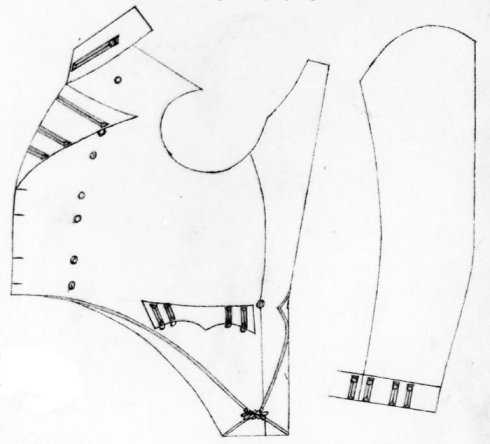Several earlier posts here (links below) have looked at the distinctive cavalry-oriented styling of light company officers’ jackets, chiefly in the Militia. On the premise that someone out there might be as curious about this fashion as I am, here are a couple more examples, both of the North Gloucestershire Militia, and both from the Hawkes tailor’s book at the National Army Museum. (Thanks to Ben Townsend for access to these images. Click to enlarge.)
First up is a double breasted jacket (dark blue facings) with two rows of 15 buttons, embroidered motifs on collar and pointed cuffs, and unusual bastion pointed turnbacks edged in a narrow blue velvet ribbon. The drawing has been updated with a pencil scrawl: “This Jacket wrong, altered to SB 3 Rows Buttons twist holes on each forepart.”
And sure enough, a later page shows the new single breasted pattern. This sports three rows of 18 “worked” holes, but with only 15 buttons on the outer rows, instructions being given for the top three to “die” under the wing and strap, which is not fully shown in the drawing. The pointed cuffs bear four buttons, one on the blue cuff and three above, with holes as inverted chevrons. The wings are specified as scarlet embroidered in silver, and silver embroidered bugles mark the turnbacks.
As a bonus, a pencil sketch tucked into the corner shows the accompanying waistcoat. (Such waistcoats are rarely pictured.) This is captioned: “White Quilting waistcoat trim’d Russia Braid sugar Loaf Buttons.” I assume the braid was white. The drawings shows 21 buttons (so 63 in total) , loops terminating in a crow’s foot, and three “eyes” in the braiding to the front of the collar. You can’t have too many buttons on a good waistcoat.
Previous posts on this topic show comparable jackets for the Manchester Local Militia, the Beverley Volunteers, the Sheffield Local Militia and South Gloucestershire Militia. What appears to be a similar jacket for the 21st Foot is discussed here.



